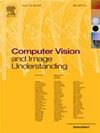CSGN:CLIP-driven semantic guidance network for Clothes-Changing Person Re-Identification
IF 3.5
3区 计算机科学
Q2 COMPUTER SCIENCE, ARTIFICIAL INTELLIGENCE
引用次数: 0
Abstract
Clothes-Changing Person Re-identification (CCReID) aims to match identities across images of individuals in different attires. Due to the significant appearance variations caused by clothing changes, distinguishing the same identity becomes challenging, while the differences between distinct individuals are often subtle. To address this, we reduce the impact of clothing information on identity judgment by introducing linguistic modalities. Considering CLIP’s (Contrastive Language-Image Pre-training) ability to align high-level semantic information with visual features, we propose a CLIP-driven Semantic Guidance Network (CSGN), which consists of a Multi-Description Generator (MDG), a Visual Semantic Steering module (VSS), and a Heterogeneous Semantic Fusion loss (HSF). Specifically, to mitigate the color sensitivity of CLIP’s text encoder, we design the MDG to generate pseudo-text in both RGB and grayscale modalities, incorporating a combined loss function for text-image mutuality. This helps reduce the encoder’s bias towards color. Additionally, to improve the CLIP visual encoder’s ability to extract identity-independent features, we construct the VSS, which combines ResNet and ViT feature extractors to enhance visual feature extraction. Finally, recognizing the complementary nature of semantics in heterogeneous descriptions, we use HSF, which constrains visual features by focusing not only on pseudo-text derived from RGB but also on pseudo-text derived from grayscale, thereby mitigating the influence of clothing information. Experimental results show that our method outperforms existing state-of-the-art approaches.
基于clip驱动的换装人再识别语义引导网络
换衣人再识别(CCReID)旨在匹配不同着装的个人图像中的身份。由于服装的变化会导致显著的外貌差异,区分相同的身份变得具有挑战性,而不同个体之间的差异往往是微妙的。为了解决这个问题,我们通过引入语言模式来减少服装信息对身份判断的影响。考虑到CLIP(对比语言-图像预训练)将高级语义信息与视觉特征对齐的能力,我们提出了一个由多描述生成器(MDG)、视觉语义转向模块(VSS)和异构语义融合损失(HSF)组成的CLIP驱动的语义引导网络(CSGN)。具体来说,为了减轻CLIP文本编码器的颜色敏感性,我们设计了MDG来生成RGB和灰度模式的伪文本,并结合了文本-图像互性的组合损失函数。这有助于减少编码器对颜色的偏见。此外,为了提高CLIP视觉编码器提取身份无关特征的能力,我们构建了VSS,该VSS结合ResNet和ViT特征提取器来增强视觉特征提取。最后,认识到异构描述中语义的互补性,我们使用HSF,它不仅关注来自RGB的伪文本,还关注来自灰度的伪文本,从而限制视觉特征,从而减轻服装信息的影响。实验结果表明,该方法优于现有的最先进的方法。
本文章由计算机程序翻译,如有差异,请以英文原文为准。
求助全文
约1分钟内获得全文
求助全文
来源期刊

Computer Vision and Image Understanding
工程技术-工程:电子与电气
CiteScore
7.80
自引率
4.40%
发文量
112
审稿时长
79 days
期刊介绍:
The central focus of this journal is the computer analysis of pictorial information. Computer Vision and Image Understanding publishes papers covering all aspects of image analysis from the low-level, iconic processes of early vision to the high-level, symbolic processes of recognition and interpretation. A wide range of topics in the image understanding area is covered, including papers offering insights that differ from predominant views.
Research Areas Include:
• Theory
• Early vision
• Data structures and representations
• Shape
• Range
• Motion
• Matching and recognition
• Architecture and languages
• Vision systems
 求助内容:
求助内容: 应助结果提醒方式:
应助结果提醒方式:


